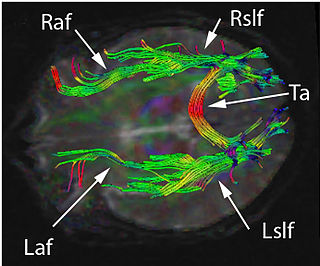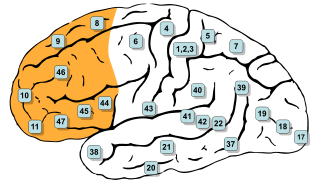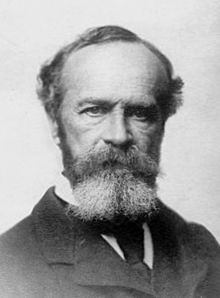Recall in memory refers to the mental process of retrieval of information from the past. Along with encoding and storage, it is one of the three core processes of memory. There are three main types of recall: free recall, cued recall and serial recall. Psychologists test these forms of recall as a way to study the memory processes of humans and animals. Two main theories of the process of recall are the two-stage theory and the theory of encoding specificity.

Anomic aphasia is a mild, fluent type of aphasia where individuals have word retrieval failures and cannot express the words they want to say. By contrast, anomia is a deficit of expressive language, and a symptom of all forms of aphasia, but patients whose primary deficit is word retrieval are diagnosed with anomic aphasia. Individuals with aphasia who display anomia can often describe an object in detail and maybe even use hand gestures to demonstrate how the object is used, but cannot find the appropriate word to name the object. Patients with anomic aphasia have relatively preserved speech fluency, repetition, comprehension, and grammatical speech.
The spacing effect demonstrates that learning is more effective when study sessions are spaced out. This effect shows that more information is encoded into long-term memory by spaced study sessions, also known as spaced repetition or spaced presentation, than by massed presentation ("cramming").
Explicit memory is one of the two main types of long-term human memory, the other of which is implicit memory. Explicit memory is the conscious, intentional recollection of factual information, previous experiences, and concepts. This type of memory is dependent upon three processes: acquisition, consolidation, and retrieval.

In mammalian brain anatomy, the prefrontal cortex (PFC) covers the front part of the frontal lobe of the cerebral cortex. It is the association cortex in the frontal lobe. The PFC contains the Brodmann areas BA8, BA9, BA10, BA11, BA12, BA13, BA14, BA24, BA25, BA32, BA44, BA45, BA46, and BA47.
Memory has the ability to encode, store and recall information. Memories give an organism the capability to learn and adapt from previous experiences as well as build relationships. Encoding allows a perceived item of use or interest to be converted into a construct that can be stored within the brain and recalled later from long-term memory. Working memory stores information for immediate use or manipulation, which is aided through hooking onto previously archived items already present in the long-term memory of an individual.
The generation effect is a phenomenon whereby information is better remembered if it is generated from one's own mind rather than simply read. Researchers have struggled to account for why the generated information is better recalled than read information, but no single explanation has been sufficient to explain everything.
Metamemory or Socratic awareness, a type of metacognition, is both the introspective knowledge of one's own memory capabilities and the processes involved in memory self-monitoring. This self-awareness of memory has important implications for how people learn and use memories. When studying, for example, students make judgments of whether they have successfully learned the assigned material and use these decisions, known as "judgments of learning", to allocate study time.
In psychology, context-dependent memory is the improved recall of specific episodes or information when the context present at encoding and retrieval are the same. In a simpler manner, "when events are represented in memory, contextual information is stored along with memory targets; the context can therefore cue memories containing that contextual information". One particularly common example of context-dependence at work occurs when an individual has lost an item in an unknown location. Typically, people try to systematically "retrace their steps" to determine all of the possible places where the item might be located. Based on the role that context plays in determining recall, it is not at all surprising that individuals often quite easily discover the lost item upon returning to the correct context. This concept is heavily related to the encoding specificity principle.
Priming is a concept in psychology to describe how exposure to one stimulus may influence a response to a subsequent stimulus, without conscious guidance or intention. The priming effect is the positive or negative effect of a rapidly presented stimulus on the processing of a second stimulus that appears shortly after. Generally speaking, the generation of priming effect depends on the existence of some positive or negative relationship between priming and target stimuli. For example, the word nurse might be recognized more quickly following the word doctor than following the word bread. Priming can be perceptual, associative, repetitive, positive, negative, affective, semantic, or conceptual. Priming effects involve word recognition, semantic processing, attention, unconscious processing, and many other issues, and are related to differences in various writing systems. How quickly this effect occurs is contested; some researchers claim that priming effects are almost instantaneous.
Neuroscience of multilingualism is the study of multilingualism within the field of neurology. These studies include the representation of different language systems in the brain, the effects of multilingualism on the brain's structural plasticity, aphasia in multilingual individuals, and bimodal bilinguals. Neurological studies of multilingualism are carried out with functional neuroimaging, electrophysiology, and through observation of people who have suffered brain damage.
Bilingual interactive activation plus (BIA+) is a model for understanding the process of bilingual language comprehension and consists of two interactive subsystems: the word identification subsystem and task/decision subsystem. It is the successor of the Bilingual Interactive Activation (BIA) model which was updated in 2002 to include phonologic and semantic lexical representations, revise the role of language nodes, and specify the purely bottom-up nature of bilingual language processing.
The encoding specificity principle is the general principle that matching the encoding contexts of information at recall assists in the retrieval of episodic memories. It provides a framework for understanding how the conditions present while encoding information relate to memory and recall of that information.
In psychology, a lemma is an abstract conceptual form of a word that has been mentally selected prior to the early stages of speech production. This concept is used to explain how the process of generating speech occurs. In particular, lemmas are seen as the mental representations of words that are organised and retrieved from memory before they are eventually spoken. A lemma represents a specific meaning but does not have any specific sounds that are attached to it.
The mental lexicon is a component of the human language faculty that contains information regarding the composition of words, such as their meanings, pronunciations, and syntactic characteristics. The mental lexicon is used in linguistics and psycholinguistics to refer to individual speakers' lexical, or word, representations. However, there is some disagreement as to the utility of the mental lexicon as a scientific construct.
Retrieval-induced forgetting (RIF) is a memory phenomenon where remembering causes forgetting of other information in memory. The phenomenon was first demonstrated in 1994, although the concept of RIF has been previously discussed in the context of retrieval inhibition.

Reconstructive memory is a theory of memory recall, in which the act of remembering is influenced by various other cognitive processes including perception, imagination, motivation, semantic memory and beliefs, amongst others. People view their memories as being a coherent and truthful account of episodic memory and believe that their perspective is free from an error during recall. However, the reconstructive process of memory recall is subject to distortion by other intervening cognitive functions and operations such as individual perceptions, social influences, and world knowledge, all of which can lead to errors during reconstruction.

Bilingualism is the regular use of two fluent languages, and bilinguals are those individuals who need and use two languages in their everyday lives. A person's bilingual memories are heavily dependent on the person's fluency, the age the second language was acquired, and high language proficiency to both languages. High proficiency provides mental flexibility across all domains of thought and forces them to adopt strategies that accelerate cognitive development. People who are bilingual integrate and organize the information of two languages, which creates advantages in terms of many cognitive abilities, such as intelligence, creativity, analogical reasoning, classification skills, problem solving, learning strategies, and thinking flexibility.
Embodied bilingual language, also known as L2 embodiment, is the idea that people mentally simulate their actions, perceptions, and emotions when speaking and understanding a second language (L2) as with their first language (L1). It is closely related to embodied cognition and embodied language processing, both of which only refer to native language thinking and speaking. An example of embodied bilingual language would be situation in which a L1 English speaker learning Spanish as a second language hears the word rápido ("fast") in Spanish while taking notes and then proceeds to take notes more quickly.
In psycholinguistics, semantic processing is the stage of language processing that occurs after one hears a word and encodes its meaning: the mind relates the word to other words with similar meanings. Once a word is perceived, it is placed in a context mentally that allows for a deeper processing. Therefore, semantic processing produces memory traces that last longer than those produced by shallow processing, since shallow processing produces fragile memory traces that decay rapidly.





